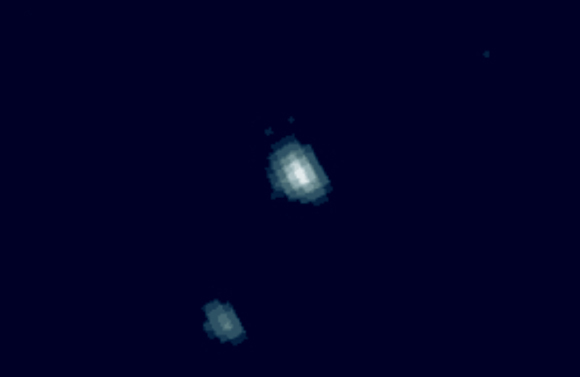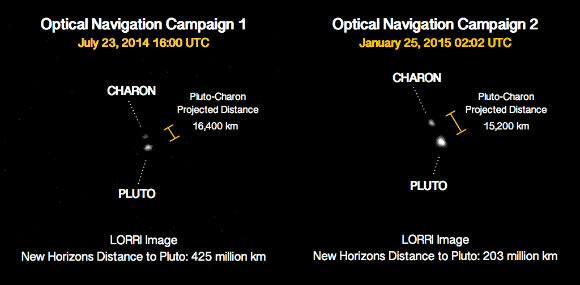NASA’s New Horizons spacecraft has acquired new images of the Pluto system. The images, taken with spacecraft’s Long-Range Reconnaissance Imager (LORRI) on January 25 and 27, are the first acquired during the 2015 approach to Pluto and its moons, which culminates with a close flyby of the system on July 14.

The image of Pluto and its moon Charon, taken by New Horizons spacecraft on January 27, was magnified few times to make the objects more visible. Image credit: NASA / Johns Hopkins University Applied Physics Laboratory / Southwest Research Institute.
Pluto discoverer Clyde Tombaugh (February 4, 1906 – January 17, 1997) could only dream of a spacecraft flying past the small planet he spotted on the edges of the Solar System in 1930.
Yet the newest images of the dwarf planet and its moon from New Horizons probe – released February 4, 2015, on the 109th birthday of the American astronomer – hint at just how close that dream is to coming true.
“My dad would be thrilled with New Horizons,” said Clyde Tombaugh’s daughter Annette Tombaugh, of Las Cruces, New Mexico.
“To actually see the planet that he had discovered, and find out more about it – to get to see the moons of Pluto – he would have been astounded. I’m sure it would have meant so much to him if he were still alive today.”
Dr Alan Stern from the Southwest Research Institute, who is the New Horizons principal investigator, added: “this is our birthday tribute to Professor Tombaugh and the Tombaugh family, in honor of his discovery and life achievements – which truly became a harbinger of 21st century planetary astronomy.”
“These images of Pluto, clearly brighter and closer than those New Horizons took last July from twice as far away, represent our first steps at turning the pinpoint of light Clyde saw in the telescopes at Lowell Observatory 85 years ago, into a planet before the eyes of the world this summer.”

A comparison of images of Pluto and Charon, taken in July 2014 and January 2015; between takes, New Horizons had more than halved its distance to Pluto, from about 425 to 203 million km; the images were magnified four times to make Pluto and Charon more visible; both images were rotated to show the celestial north pole at the top. Image credit: NASA / Johns Hopkins University Applied Physics Laboratory / Southwest Research Institute.
Over the next few months, LORRI will take hundreds of pictures of Pluto against star fields to refine the team’s estimates of New Horizons’ distance to the dwarf planet.
As in these first images, the system will resemble little more than bright dots in the camera’s view until late spring, but mission navigators will use these images to design course-correcting engine maneuvers that precisely aim New Horizons on approach.
The first such maneuver based on these optical navigation images is scheduled for March 10.
“Pluto is finally becoming more than just a pinpoint of light,” said Dr Hal Weaver from the Johns Hopkins University Applied Physics Laboratory in Laurel, Maryland.
“LORRI has now resolved Pluto, and the dwarf planet will continue to grow larger and larger in the images as New Horizons spacecraft hurtles toward its targets.”
“The new LORRI images also demonstrate that the camera’s performance is unchanged since it was launched more than nine years ago.”







